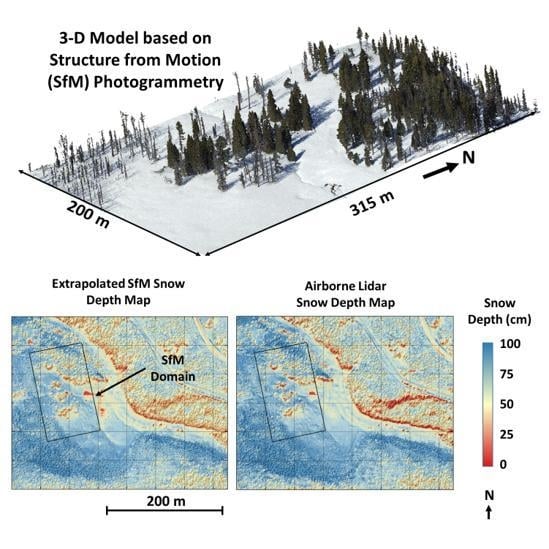Structure from Motion of Multi-Angle RPAS Imagery Complements Larger-Scale Airborne Lidar Data for Cost-Effective Snow Monitoring in Mountain Forests
Abstract
1. Introduction
2. Materials and Methods
2.1. Field Data
2.2. Generation of Lidar Snow Depth, Density, and SWE Maps
2.3. Generation of SfM Snow Depth Maps
2.4. Using SfM Snowpack Data to Supplement Lidar Snowpack Data
3. Results
3.1. Comparison Between SfM, Field-Based, and Lidar Snow Depths
3.2. SWE Monitoring Using SfM
3.3. Using Airborne Lidar to Extend the SfM Data
4. Discussion
- (1)
- Conducting an airborne lidar survey representing mid-winter to peak snowpack conditions, to provide a baseline coverage before too much melt so that there are no major snow-free areas over the study area (which would require an alternate technique to extrapolate snowpack conditions in these areas)
- (2)
- Planning SfM surveys in areas where SfM has a high chance of success (e.g., sparse canopy, gentle topography, not a whole lot of brush / low vegetation) and where a large range of snow depth variability can be observed (which can include multiple SfM plots), giving a greater ability for successful extrapolation to the larger airborne lidar domain
- (3)
- Designing complimentary ground snow surveys that capture snow conditions across a range of physiographic conditions to be able to generate a reliable first-guess snow depth map to aid in the creation of the SfM data (as well as allowing for good characterization of snow densities). These surveys should capture snow variability related to the important physiographic characteristics and snow processes for a given field site. For our area, snow depth variability was primarily influenced by the tradeoff between shading (from both terrain and vegetation and terrain influences) and interception [6]. Therefore, it was ideal to have transects spanning gradients of vegetation cover and tree shading (e.g., across forest gaps and into forest edges) and on opposing aspects.
5. Conclusions
Supplementary Materials
Author Contributions
Funding
Acknowledgments
Conflicts of Interest
References
- Bales, R.C.; Molotch, N.P.; Painter, T.H.; Dettinger, M.D.; Rice, R.; Dozier, J. Mountain hydrology of the western United States. Water Resour. Res. 2006, 42, W08432. [Google Scholar] [CrossRef]
- Bolin, B.; Seetharam, M.; Pompeii, B. Water resources, climate change, and urban vulnerability: A case study of Phoenix, Arizona. Local Environ. 2010, 15, 261–279. [Google Scholar] [CrossRef]
- Clark, S.S.; Chester, M.V.; Seager, T.P.; Eisenberg, D.A. The vulnerability of interdependent urban infrastructure systems to climate change: Could phoenix experience a katrina of extreme heat? Sustain. Resilient Infrast. 2019, 4, 21–35. [Google Scholar] [CrossRef]
- Biederman, J.; Harpold, A.; Gochis, D.; Ewers, B.; Reed, D.; Papuga, S.; Brooks, P. Increased evaporation following widespread tree mortality limits streamflow response. Water Resour. Res. 2014, 50, 5395–5409. [Google Scholar] [CrossRef]
- Brooks, P.; Vivoni, E.R. Mountain ecohydrology: Quantifying the role of vegetation in the water balance of montane catchments. Ecohydrol. Ecosyst. Land Water Process. Interact. Ecohydrogeomorphology 2008, 1, 187–192. [Google Scholar] [CrossRef]
- Broxton, P.D.; van Leeuwen, W.J.; Biederman, J.A. Forest cover and topography regulate the thin, ephemeral snowpacks of the semiarid southwest United States. Ecohydrology 2020, 13, e2202. [Google Scholar] [CrossRef]
- Ffolliott, P.F.; Gottfried, G.J.; Baker, M.B., Jr. Water yield from forest snowpack management: Research findings in Arizona and New Mexico. Water Resour. Res. 1989, 25, 1999–2007. [Google Scholar] [CrossRef]
- Gleason, K.E.; Nolin, A.W. Charred forests accelerate snow albedo decay: Parameterizing the post-fire radiative forcing on snow for three years following fire. Hydrol. Process. 2016, 30, 3855–3870. [Google Scholar] [CrossRef]
- Harpold, A.A.; Biederman, J.A.; Condon, K.; Merino, M.; Korgaonkar, Y.; Nan, T.; Sloat, L.L.; Ross, M.; Brooks, P.D. Changes in snow accumulation and ablation following the las conchas forest fire, New Mexico, USA. Ecohydrology 2014, 7, 440–452. [Google Scholar] [CrossRef]
- Jenicek, M.; Pevna, H.; Matejka, O. Canopy structure and topography effects on snow distribution at a catchment scale: Application of multivariate approaches. J. Hydrol. Hydromech. 2018, 66, 43–54. [Google Scholar] [CrossRef]
- Molotch, N.P.; Brooks, P.D.; Burns, S.P.; Litvak, M.; Monson, R.K.; McConnell, J.R.; Musselman, K. Ecohydrological controls on snowmelt partitioning in mixed-conifer sub-alpine forests. Ecohydrology 2009, 2, 129–142. [Google Scholar] [CrossRef]
- Robles, M.D.; Marshall, R.M.; O′Donnell, F.; Smith, E.B.; Haney, J.A.; Gori, D.F. Effects of climate variability and accelerated forest thinning on watershed-scale runoff in southwestern USA ponderosa pine forests. PLoS ONE 2014, 9, e111092. [Google Scholar] [CrossRef]
- Svoma, B.M. Canopy effects on snow sublimation from a central Arizona Basin. J. Geophys. Res. Atmos. 2017, 122, 20–46. [Google Scholar] [CrossRef]
- Broxton, P.; Harpold, A.; Biederman, J.; Troch, P.A.; Molotch, N.; Brooks, P. Quantifying the effects of vegetation structure on snow accumulation and ablation in mixed-conifer forests. Ecohydrology 2015, 8, 1073–1094. [Google Scholar] [CrossRef]
- Gustafson, J.R.; Brooks, P.; Molotch, N.; Veatch, W. Estimating snow sublimation using natural chemical and isotopic tracers across a gradient of solar radiation. Water Resour. Res. 2010, 46, W12511. [Google Scholar] [CrossRef]
- Musselman, K.; Molotch, N.P.; Brooks, P.D. Effects of vegetation on snow accumulation and ablation in a mid-latitude sub-alpine forest. Hydrol. Process. An. Int. J. 2008, 22, 2767–2776. [Google Scholar] [CrossRef]
- Rinehart, A.J.; Vivoni, E.R.; Brooks, P.D. Effects of vegetation, albedo, and solar radiation sheltering on the distribution of snow in the Valles Caldera, New Mexico. Ecohydrol. Ecosyst. Land Water Process. Interact. Ecohydrogeomorphology 2008, 1, 253–270. [Google Scholar] [CrossRef]
- Veatch, W.; Brooks, P.; Gustafson, J.; Molotch, N. Quantifying the effects of forest canopy cover on net snow accumulation at a continental, mid-latitude site. Ecohydrology 2009, 2, 115–128. [Google Scholar] [CrossRef]
- Molotch, N.; Colee, M.; Bales, R.; Dozier, J. Estimating the spatial distribution of snow water equivalent in an alpine basin using binary regression tree models: The impact of digital elevation data and independent variable selection. Hydrol. Process. An. Int. J. 2005, 19, 1459–1479. [Google Scholar] [CrossRef]
- Harder, P.; Pomeroy, J.W.; Helgason, W.D. Advances in mapping sub-canopy snow depth with unmanned aerial vehicles using structure from motion and lidar techniques. Cryosphere Discuss. 2019, 2019, 1–31. [Google Scholar]
- Nolin, A.W. Recent advances in remote sensing of seasonal snow. J Glaciol. 2010, 56, 1141–1150. [Google Scholar] [CrossRef]
- Vikhamar, D.; Solberg, R. Subpixel mapping of snow cover in forests by optical remote sensing. Remote Sens. Environ. 2003, 84, 69–82. [Google Scholar] [CrossRef]
- Dong, C.; Menzel, L. Snow process monitoring in montane forests with time-lapse photography. Hydrol. Process. 2017, 31, 2872–2886. [Google Scholar] [CrossRef]
- McCabe, M.F.; Rodell, M.; Alsdorf, D.E.; Miralles, D.G.; Uijlenhoet, R.; Wagner, W.; Lucieer, A.; Houborg, R.; Verhoest, N.E.C.; Franz, T.E.; et al. The future of Earth observation in hydrology. Hydrol. Earth Syst. Sci. 2017, 21, 3879–3914. [Google Scholar] [CrossRef] [PubMed]
- Appel, I. Uncertainty in satellite remote sensing of snow fraction for water resources management. Front. Earth Sci. 2018, 12, 711–727. [Google Scholar]
- Piazzi, G.; Tanis, C.M.; Kuter, S.; Simsek, B.; Puca, S.; Toniazzo, A.; Takala, M.; Akyürek, Z.; Nadir Arslan, A.; Gabellani, S.; et al. Cross-country assessment of H-SAF snow products by Sentinel-2 imagery validated against in-situ observations and webcam photography. Geosciences 2019, 9, 129. [Google Scholar] [CrossRef]
- Deems, J.S.; Painter, T.H.; Finnegan, D.C. Lidar measurement of snow depth: A review. J. Glaciol. 2013, 59, 467–479. [Google Scholar] [CrossRef]
- Hedrick, A.R.; Marks, D.; Havens, S.; Robertson, M.; Johnson, M.; Sandusky, M.; Marshall, H.P.; Kormos, P.R.; Bormann, K.J.; Painter, T.H. Direct insertion of NASA airborne snow observatory-derived snow depth time series into the iSnobal energy balance snow model. Water Resour. Res. 2018, 54, 8045–8063. [Google Scholar] [CrossRef]
- Painter, T.H.; Berisford, D.F.; Boardman, J.W.; Bormann, K.J.; Deems, J.S.; Gehrke, F.; Hedrick, A.; Joyce, M.; Laidlaw, R.; Marks, D.; et al. The airborne snow observatory: Fusion of scanning lidar, imaging spectrometer, and physically-based modeling for mapping snow water equivalent and snow albedo. Remote Sens. Environ. 2016, 184, 139–152. [Google Scholar] [CrossRef]
- Harpold, A.; Guo, Q.; Molotch, N.; Brooks, P.; Bales, R.; Fernandez-Diaz, J.; Musselman, K.; Swetnam, T.; Kirchner, P.; Meadows, M.W.; et al. LiDAR-derived snowpack data sets from mixed conifer forests across the western United States. Water Resour. Res. 2014, 50, 2749–2755. [Google Scholar] [CrossRef]
- McClelland, M.P., II; Hale, D.S.; van Aardt, J. A comparison of manned and unmanned aerial Lidar systems in the context of sustainable forest management. In Proceedings of the Autonomous Air and Ground Sensing Systems for Agricultural Optimization and Phenotyping III 106640S, Orlando, FL, USA, 18–19 April 2018. [Google Scholar]
- Hummel, S.; Hudak, A.; Uebler, E.; Falkowski, M.; Megown, K. A comparison of accuracy and cost of LiDAR versus stand exam data for landscape management on the Malheur National Forest. J. For. 2011, 109, 267–273. [Google Scholar]
- Lendzioch, T.; Langhammer, J.; Jenicek, M. Estimating snow depth and leaf area index based on UAV digital photogrammetry. Sensors 2019, 19, 1027. [Google Scholar] [CrossRef]
- Lendzioch, T.; Langhammer, J.; Jenicek, M. Tracking forest and open area effects on snow accumulation by unmanned aerial vehicle photogrammetry. Int. Arch. Photogramm. Remote Sens. Spat. Inf. Sci. 2016, 41, 917–923. [Google Scholar] [CrossRef]
- Westoby, M.J.; Brasington, J.; Glasser, N.F.; Hambrey, M.J.; Reynolds, J.M. ‘Structure-from-motion’ photogrammetry: A low-cost, effective tool for geoscience applications. Geomorphology 2012, 179, 300–314. [Google Scholar] [CrossRef]
- Cimoli, E.; Marcer, M.; Vandecrux, B.; Bøggild, C.E.; Williams, G.; Simonsen, S.B. Application of low-cost UASs and digital photogrammetry for high-resolution snow depth mapping in the Arctic. Remote Sen. 2017, 9, 1144. [Google Scholar] [CrossRef]
- Goetz, J.; Brenning, A. Quantifying uncertainties in snow depth mapping from structure from motion photogrammetry in an alpine area. Water Resour. Res. 2019, 55, 7772–7783. [Google Scholar] [CrossRef]
- Meyer, J.; Skiles, S.M. Assessing the ability of structure from motion to map high-resolution snow surface elevations in complex terrain: A case study from senator beck basin, CO. Water Resour. Res. 2019, 55, 6596–6605. [Google Scholar] [CrossRef]
- Nolan, M.; Larsen, C.; Sturm, M. Mapping snow-depth from manned-aircraft on landscape scales at centimeter resolution using structure-from-motion photogrammetry. Cryosphere Discuss. 2015, 9, 333–381. [Google Scholar] [CrossRef]
- Bühler, Y.; Adams, M.S.; Bösch, R.; Stoffel, A. Mapping snow depth in alpine terrain with unmanned aerial systems (UASs): Potential and limitations. Cryosphere 2016, 10, 1075–1088. [Google Scholar] [CrossRef]
- Federman, A.; Quintero, M.S.; Kretz, S.; Gregg, J.; Lengies, M.; Ouimet, C.; Laliberte, J. UAV photogrammetric workflows: A best practice guideline. Int. Arch. Photogramm. Remote Sens. Spat. Inf. Sci. 2017, 42, 237–244. [Google Scholar] [CrossRef]
- Adams, M.S.; Bühler, Y.; Fromm, R. Multitemporal accuracy and precision assessment of unmanned aerial system photogrammetry for slope-scale snow depth maps in alpine terrain. Pure Appl. Geophys. 2018, 175, 3303–3324. [Google Scholar] [CrossRef]
- Avanzi, F.; Bianchi, A.; Cina, A.; De Michele, C.; Maschio, P.; Pagliari, D.; Passoni, D.; Pinto, L.; Piras, M.; Rossi, L. Centimetric accuracy in snow depth using unmanned aerial system photogrammetry and a multistation. Remote Sens. 2018, 10, 765. [Google Scholar] [CrossRef]
- Baños, I.M.; García, A.R.; i Alavedra, J.M.; i Figueras, P.O.; Iglesias, J.P.; i Figueras, P.M.; López, J.T. Assessment of airborne LIDAR for snowpack depth modeling. Boletín de la Soc. Geológica Mex. 2011, 63, 95–107. [Google Scholar] [CrossRef]
- Deems, J.S.; Painter, T.H. Lidar measurement of snow depth: Accuracy and error sources. In Proceedings of the 2006 International Snow Science Workshop, Telluride, CO, USA, 1–6 October 2006; pp. 330–338. [Google Scholar]
- Grünewald, T.; Schirmer, M.; Mott, R.; Lehning, M. Spatial and temporal variability of snow depth and SWE in a small mountain catchment. Cryosphere 2010, 4, 215–225. [Google Scholar] [CrossRef]
- López-Moreno, J.I.; Fassnacht, S.; Beguería, S.; Latron, J. Variability of snow depth at the plot scale: Implications for mean depth estimation and sampling strategies. Cryosphere 2011, 5, 617–629. [Google Scholar] [CrossRef]
- Redpath, T.A.; Sirguey, P.; Cullen, N.J. Repeat mapping of snow depth across an alpine catchment with RPAS photogrammetry. Cryosphere 2018, 12, 3477–3497. [Google Scholar] [CrossRef]
- Tinkham, W.T.; Smith, A.M.; Marshall, H.-P.; Link, T.E.; Falkowski, M.J.; Winstral, A.H. Quantifying spatial distribution of snow depth errors from LiDAR using random forest. Remote Sens. Environ. 2014, 141, 105–115. [Google Scholar] [CrossRef]
- Trujillo, E.; Ramírez, J.A.; Elder, K.J. Topographic, meteorologic, and canopy controls on the scaling characteristics of the spatial distribution of snow depth fields. Water Resour. Res. 2007, 43, W07409. [Google Scholar] [CrossRef]
- Kennedy, M.C.; Johnson, M.C. Fuel treatment prescriptions alter spatial patterns of fire severity around the wildland–urban interface during the wallow fire, Arizona, USA. For. Ecol.Manag. 2014, 318, 122–132. [Google Scholar] [CrossRef]
- QSI. 4FRI Snow Analysis 2019, Arizona LIDAR; Technical Data Report; QSI: Corvallis, OR, USA, 2019. [Google Scholar]
- Biederman, J.A.; Brooks, P.D.; Harpold, A.A.; Gochis, D.J.; Gutmann, E.; Reed, D.E.; Pendall, E.; Ewers, B.E. Multiscale observations of snow accumulation and peak snowpack following widespread, insect-induced lodgepole pine mortality. Ecohydrology 2014, 7, 150–162. [Google Scholar] [CrossRef]
- Broxton, P.D.; van Leeuwen, W.J.; Biederman, J.A. Improving snow water equivalent maps with machine learning of snow survey and lidar measurements. Water Resour. Res. 2019, 55, 3739–3757. [Google Scholar] [CrossRef]
- QSI. 4FRI LiDAR: Four Forests Restoration Initiative; Technical Data Report; QSI: Corvallis, OR, USA, 2013. [Google Scholar]
- QSI. 4FRI LiDAR: Four Forests Restoration Initiative; Technical Data Report; QSI: Corvallis, OR, USA, 2014. [Google Scholar]
- QSI. 4FRI Snow Analysis, Arizona LIDAR; Technical Data Report; QSI: Corvallis, OR, USA, 2017. [Google Scholar]
- QSI. 4FRI Snow Analysis II, Arizona LIDAR; Technical Data Report; QSI: Corvallis, OR, USA, 2017. [Google Scholar]
- Zhang, W.; Qi, J.; Wan, P.; Wang, H.; Xie, D.; Wang, X.; Yan, G. An easy-to-use airborne LiDAR data filtering method based on cloth simulation. Remote Sens. 2016, 8, 501. [Google Scholar] [CrossRef]
- McGaughey, R. FUSION/LDV: Software for LiDAR Data Analysis and Visualization; Version 3.01; US Department of Agriculture, Forest Service, Pacific Northwest. Research Station; University of Washington: Seattle, WA, USA, 2012. [Google Scholar]
- Dozier, J. Mountain hydrology, snow color, and the fourth paradigm. Eostransactions Am. Geophys. Union 2011, 92, 373–374. [Google Scholar] [CrossRef]
- Wetlaufer, K.; Hendrikx, J.; Marshall, L. Spatial heterogeneity of snow density and its influence on snow water equivalence estimates in a large mountainous basin. Hydrology 2016, 3, 3. [Google Scholar] [CrossRef]
- Gao, J.; Xia, Z.-G. Fractals in physical geography. Prog. Phys. Geogr. 1996, 20, 178–191. [Google Scholar] [CrossRef]
- Deems, J.S.; Fassnacht, S.R.; Elder, K.J. Fractal distribution of snow depth from LiDAR data. J. Hydrometeorol. 2006, 7, 285–297. [Google Scholar] [CrossRef]
- Mott, R.; Schirmer, M.; Lehning, M. Scaling properties of wind and snow depth distribution in an alpine catchment. J. Geophys. Res. Atmos. 2011, 116. [Google Scholar] [CrossRef]
- Clark, M.P.; Hendrikx, J.; Slater, A.G.; Kavetski, D.; Anderson, B.; Cullen, N.J.; Kerr, T.; Örn Hreinsson, E.; Woods, R.A. Representing spatial variability of snow water equivalent in hydrologic and land-surface models: A review. Water Resour. Res. 2011, 47. [Google Scholar] [CrossRef]
- Harder, P.; Schirmer, M.; Pomeroy, J.; Helgason, W. Accuracy of snow depth estimation in mountain and prairie environments by an unmanned aerial vehicle. Cryosphere 2016, 10, 2559–2571. [Google Scholar] [CrossRef]
- Deems, J.S.; Fassnacht, S.R.; Elder, K.J. Interannual consistency in fractal snow depth patterns at two Colorado mountain sites. J. Hydrometeorol. 2008, 9, 977–988. [Google Scholar] [CrossRef]
- Schirmer, M.; Wirz, V.; Clifton, A.; Lehning, M. Persistence in intra-annual snow depth distribution: 1. Measurements and topographic control. Water Resour. Res. 2011, 47. [Google Scholar] [CrossRef]
- Erickson, T.A.; Williams, M.W.; Winstral, A. Persistence of topographic controls on the spatial distribution of snow in rugged mountain terrain, Colorado, United States. Water Resour. Res. 2005, 41. [Google Scholar] [CrossRef]
- Kuchment, L.; Gelfan, A. Statistical self-similarity of spatial variations of snow cover: Verification of the hypothesis and application in the snowmelt runoff generation models. Hydrol. Process. 2001, 15, 3343–3355. [Google Scholar] [CrossRef]
- Sturm, M.; Wagner, A.M. Using repeated patterns in snow distribution modeling: An Arctic example. Water Resour. Res. 2010, 46. [Google Scholar] [CrossRef]
- Revuelto, J.; López-Moreno, J.I.; Azorin-Molina, C.; Vicente-Serrano, S.M. Topographic control of snowpack distribution in a small catchment in the central Spanish Pyrenees: Intra-and inter-annual persistence. Cryosphere 2014, 8, 1989–2006. [Google Scholar] [CrossRef]
- Elder, K.; Dozier, J.; Michaelsen, J. Snow accumulation and distribution in an alpine watershed. Water Resour. Res. 1991, 27, 1541–1552. [Google Scholar] [CrossRef]
- Egli, L.; Jonas, T. Hysteretic dynamics of seasonal snow depth distribution in the Swiss Alps. Geophys. Res. Lett. 2009, 36. [Google Scholar] [CrossRef]
- Magand, C.; Ducharne, A.; Le Moine, N.; Gascoin, S. Introducing hysteresis in snow depletion curves to improve the water budget of a land surface model in an Alpine catchment. J. hydrometeorol. 2014, 15, 631–649. [Google Scholar] [CrossRef]
- Anderton, S.; White, S.; Alvera, B. Evaluation of spatial variability in snow water equivalent for a high mountain catchment. Hydrol. Process. 2004, 18, 435–453. [Google Scholar] [CrossRef]
- Jost, G.; Weiler, M.; Gluns, D.R.; Alila, Y. The influence of forest and topography on snow accumulation and melt at the watershed-scale. J. Hydrol. 2007, 347, 101–115. [Google Scholar] [CrossRef]
- Winstral, A.; Marks, D. Simulating wind fields and snow redistribution using terrain-based parameters to model snow accumulation and melt over a semi-arid mountain catchment. Hydrol. Process. 2002, 16, 3585–3603. [Google Scholar] [CrossRef]
- López-Moreno, J.; Pomeroy, J.; Revuelto, J.; Vicente-Serrano, S. Response of snow processes to climate change: Spatial variability in a small basin in the Spanish Pyrenees. Hydrol. Process. 2013, 27, 2637–2650. [Google Scholar] [CrossRef]
- De Michele, C.; Avanzi, F.; Passoni, D.; Barzaghi, R.; Pinto, L.; Dosso, P.; Ghezzi, A.; Gianatti, R.; Vedova, G.D. Using a fixed-wing UAS to map snow depth distribution: An evaluation at peak accumulation. Cryosphere 2016, 10, 511–522. [Google Scholar] [CrossRef]
- Liu, X. Airborne LiDAR for DEM generation: Some critical issues. Prog. Phys. Geogr. 2008, 32, 31–49. [Google Scholar]
- Gould, S.B.; Glenn, N.F.; Sankey, T.T.; McNamara, J.P. Influence of a dense, low-height shrub species on the accuracy of a LiDAR-derived DEM. Photogramm. Eng. Remote Sens. 2013, 79, 421–431. [Google Scholar] [CrossRef]
- Meng, X.; Currit, N.; Zhao, K. Ground filtering algorithms for airborne LiDAR data: A review of critical issues. Remote Sens. 2010, 2, 833–860. [Google Scholar] [CrossRef]
- Miziński, B.; Niedzielski, T. Fully-automated estimation of snow depth in near real time with the use of unmanned aerial vehicles without utilizing ground control points. Cold Reg. Sci. Technol. 2017, 138, 63–72. [Google Scholar] [CrossRef]
- Eltner, A.; Schneider, D. Analysis of different methods for 3D reconstruction of natural surfaces from parallel-axes UAV images. Photogramm. Rec. 2015, 30, 279–299. [Google Scholar] [CrossRef]
- Bormann, K.J.; Westra, S.; Evans, J.P.; McCabe, M.F. Spatial and temporal variability in seasonal snow density. J. Hydrol. 2013, 484, 63–73. [Google Scholar] [CrossRef]
- Dawson, N.; Broxton, P.; Zeng, X. A new snow density parameterization for land data initialization. J. Hydrometeorol. 2017, 18, 197–207. [Google Scholar] [CrossRef]
- López-Moreno, J.I.; Fassnacht, S.; Heath, J.; Musselman, K.; Revuelto, J.; Latron, J.; Morán-Tejeda, E.; Jonas, T. Small scale spatial variability of snow density and depth over complex alpine terrain: Implications for estimating snow water equivalent. Adv. Water Resour. 2013, 55, 40–52. [Google Scholar] [CrossRef]
- Raleigh, M.S.; Small, E.E. Snowpack density modeling is the primary source of uncertainty when mapping basin-wide SWE with lidar. Geophys. Res. Lett. 2017, 44, 3700–3709. [Google Scholar] [CrossRef]
- Fazeli, H.; Samadzadegan, F.; Dadrasjavan, F. Evaluating the potential of RTK-UAV for automatic point cloud generation in 3D rapid mapping. Int. Arch. Photogramm. Remote Sens. Spat. Inf. Sci. 2016, 41, 221. [Google Scholar] [CrossRef]
- Zhang, H.; Aldana-Jague, E.; Clapuyt, F.; Wilken, F.; Vanacker, V.; Van Oost, K. Evaluating the potential of post-processing kinematic (PPK) georeferencing for UAV-based structure-from-motion (SfM) photogrammetry and surface change detection. Earth Surf. Dyn. 2019, 7, 807–827. [Google Scholar] [CrossRef]
- Forlani, G.; Dall′Asta, E.; Diotri, F.; di Cella, U.M.; Roncella, R.; Santise, M. Quality assessment of DSMs produced from UAV flights georeferenced with on-board RTK positioning. Remote Sens. 2018, 10, 311. [Google Scholar] [CrossRef]


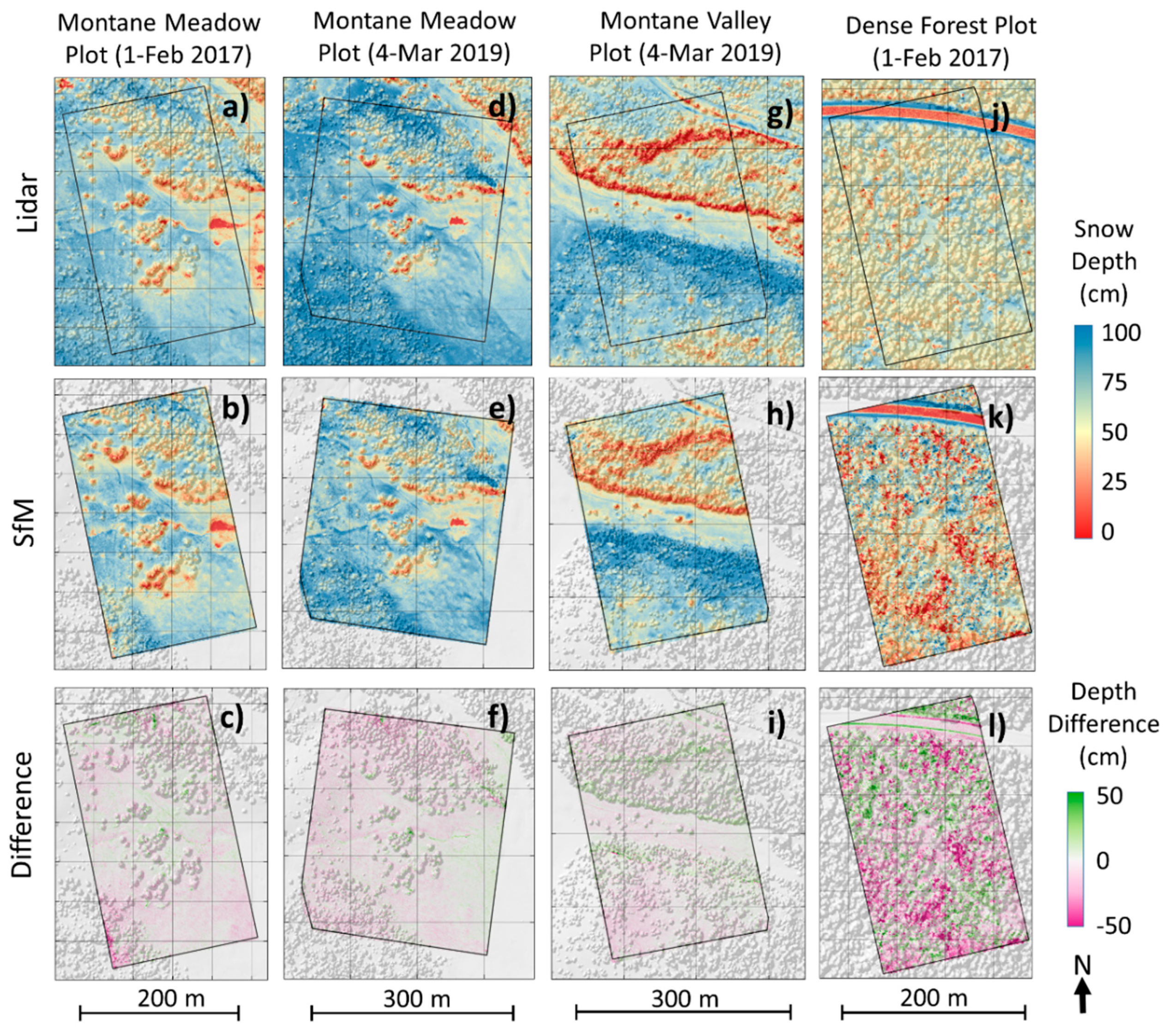
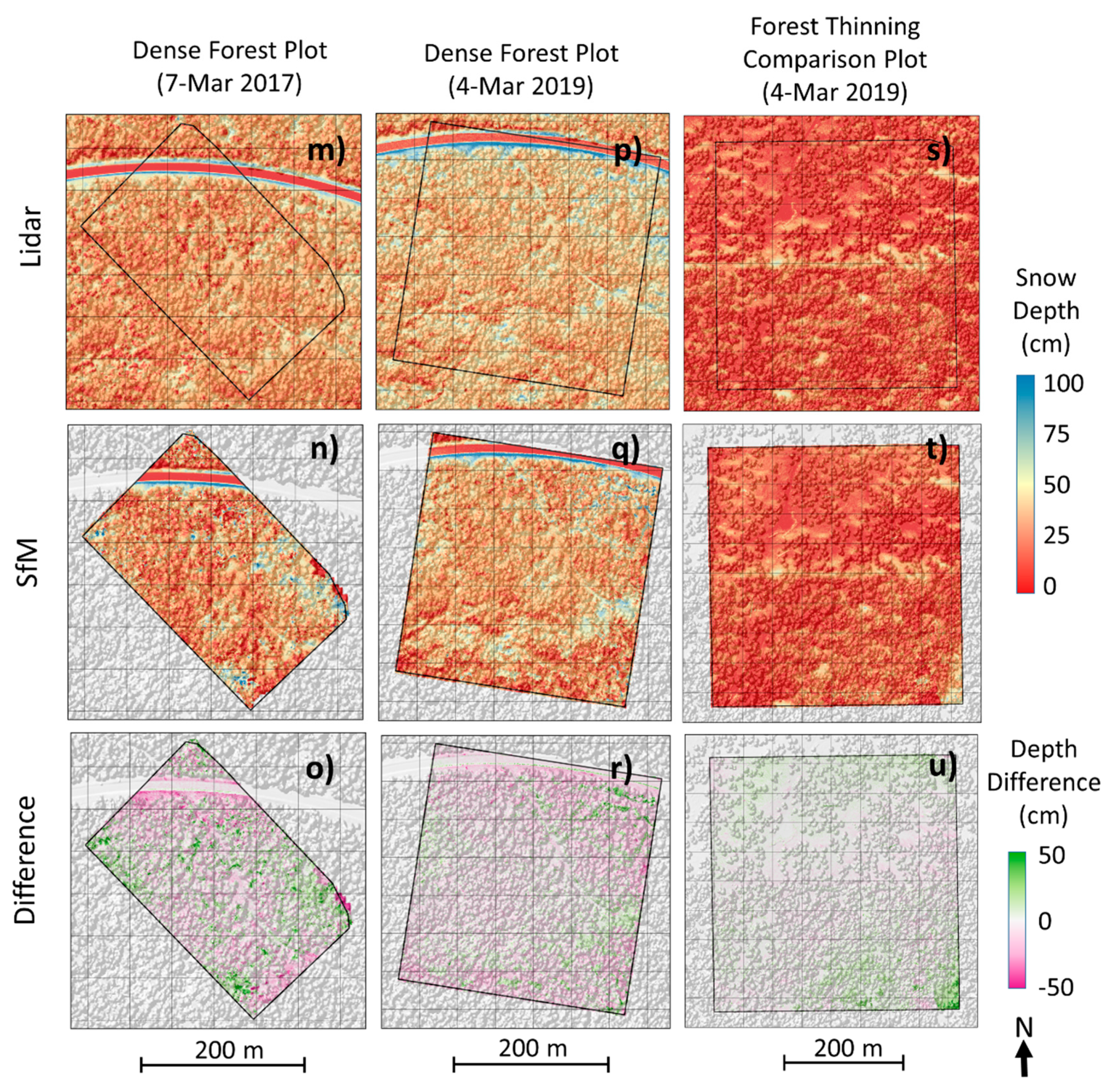
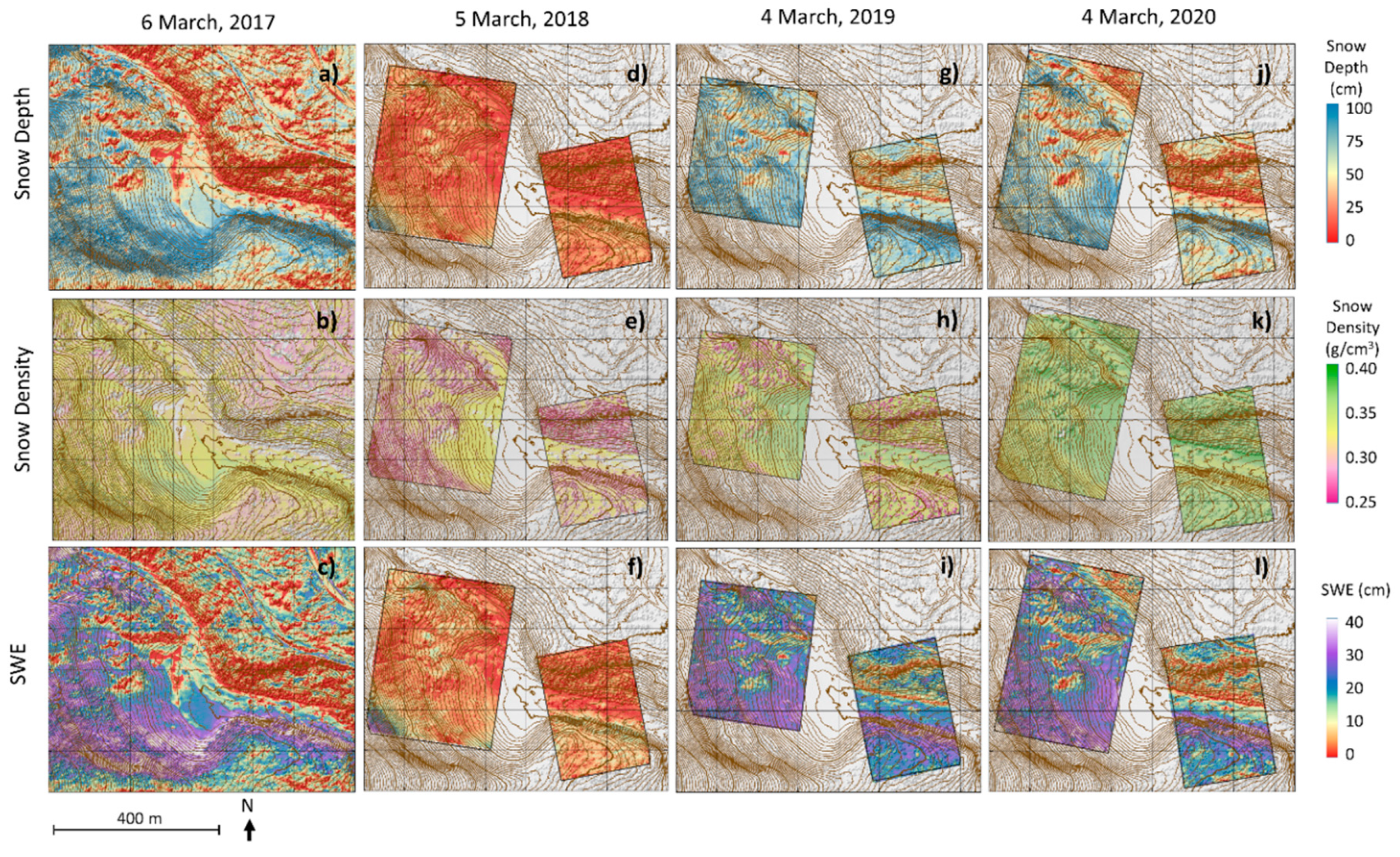
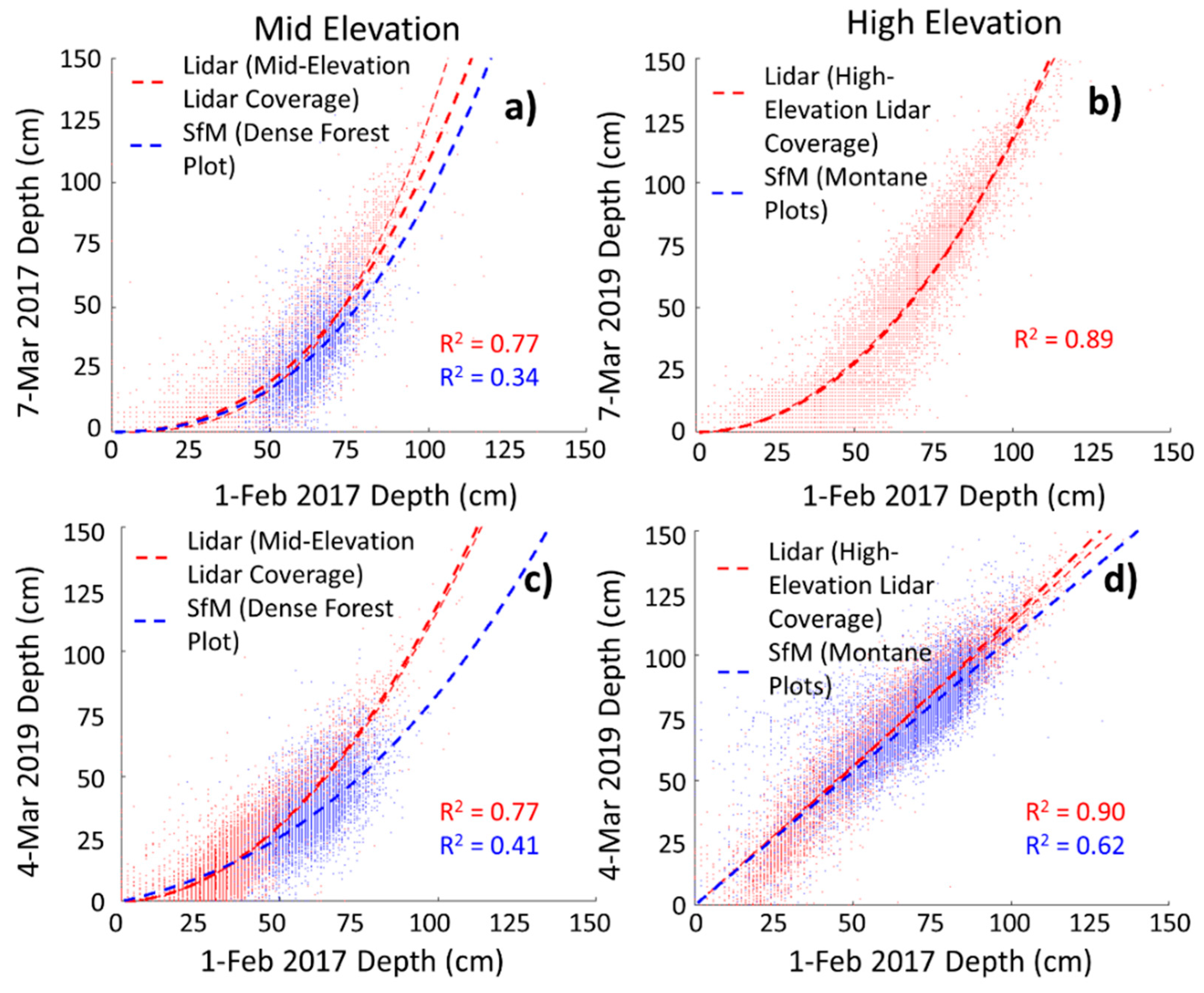
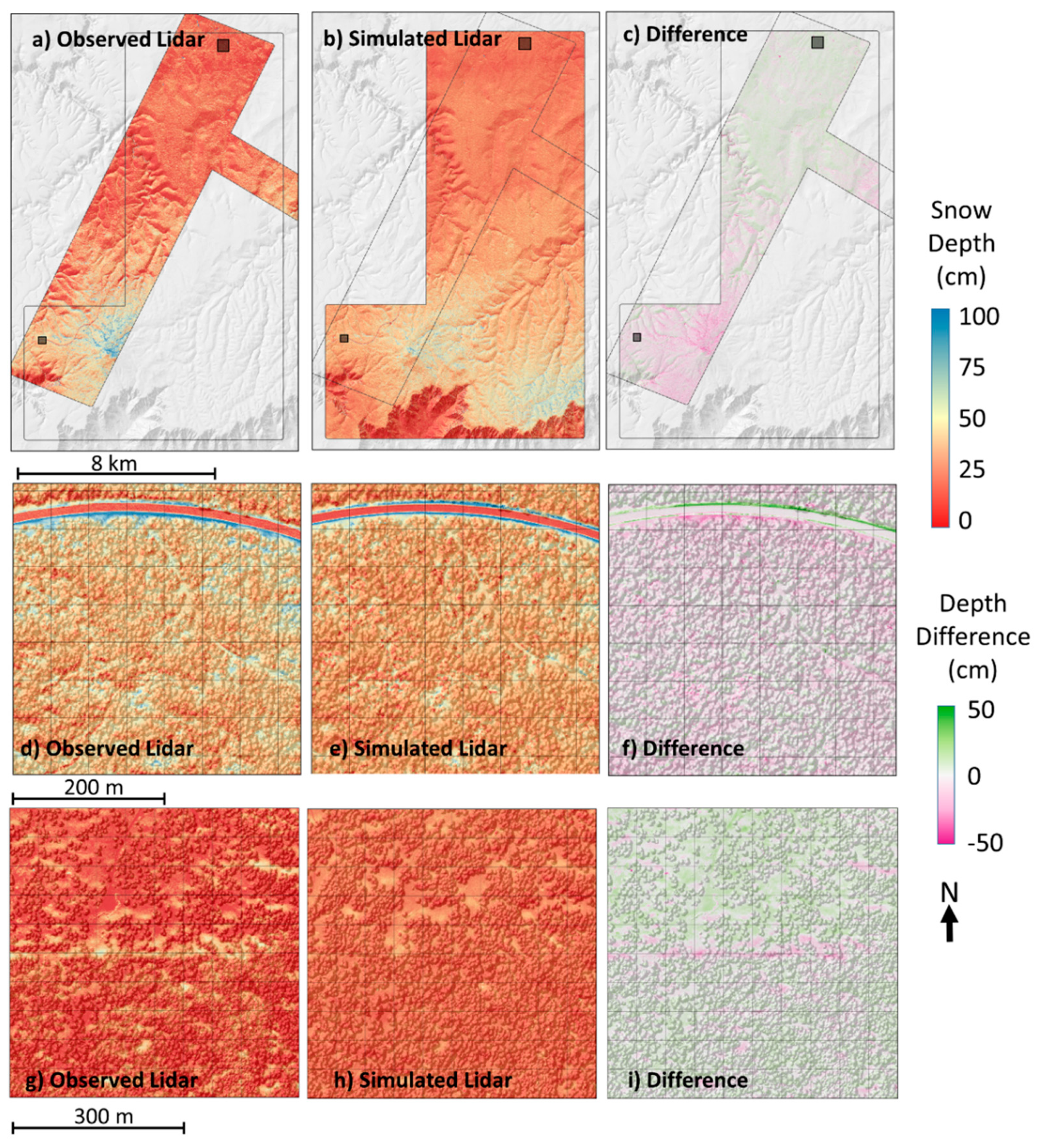
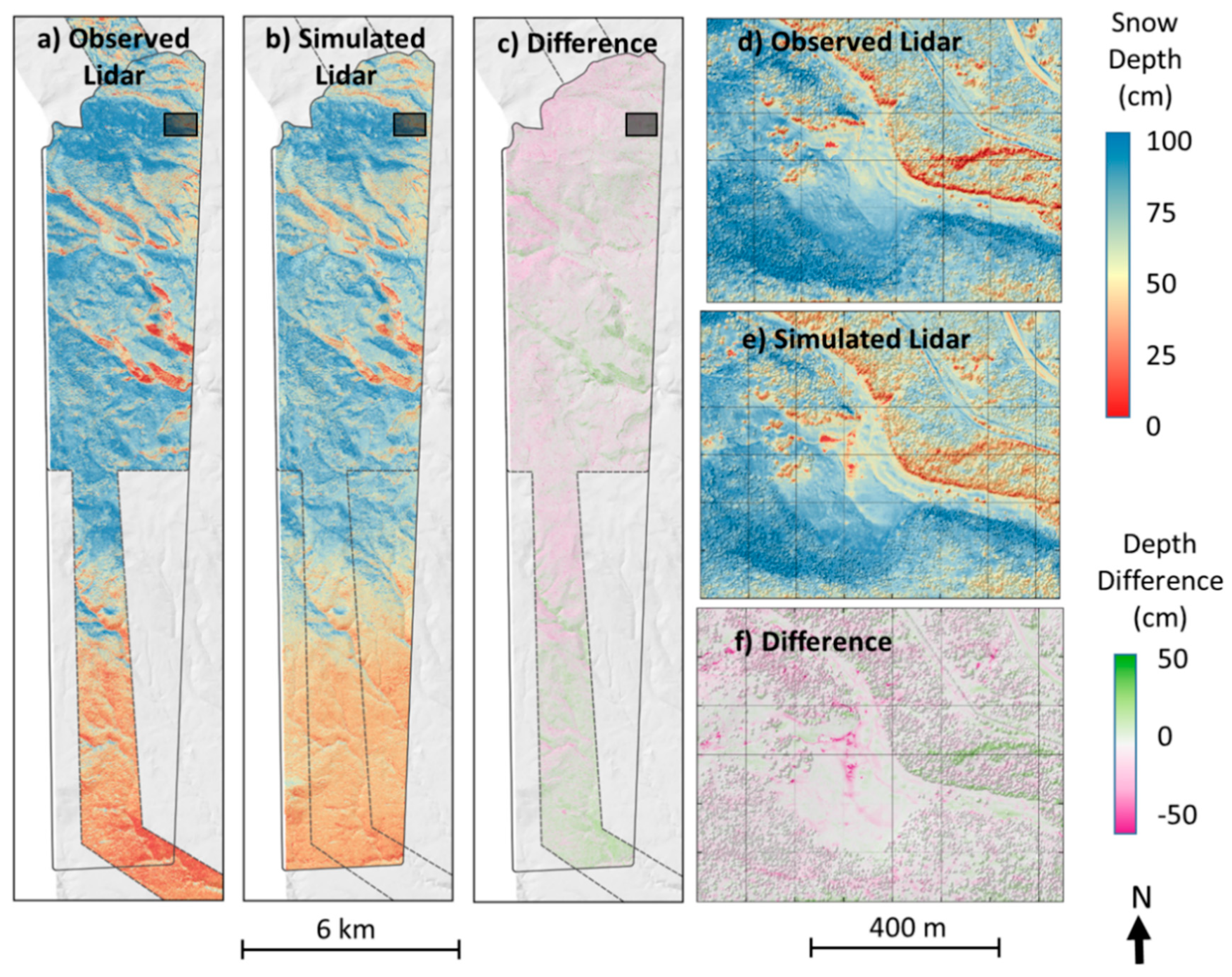
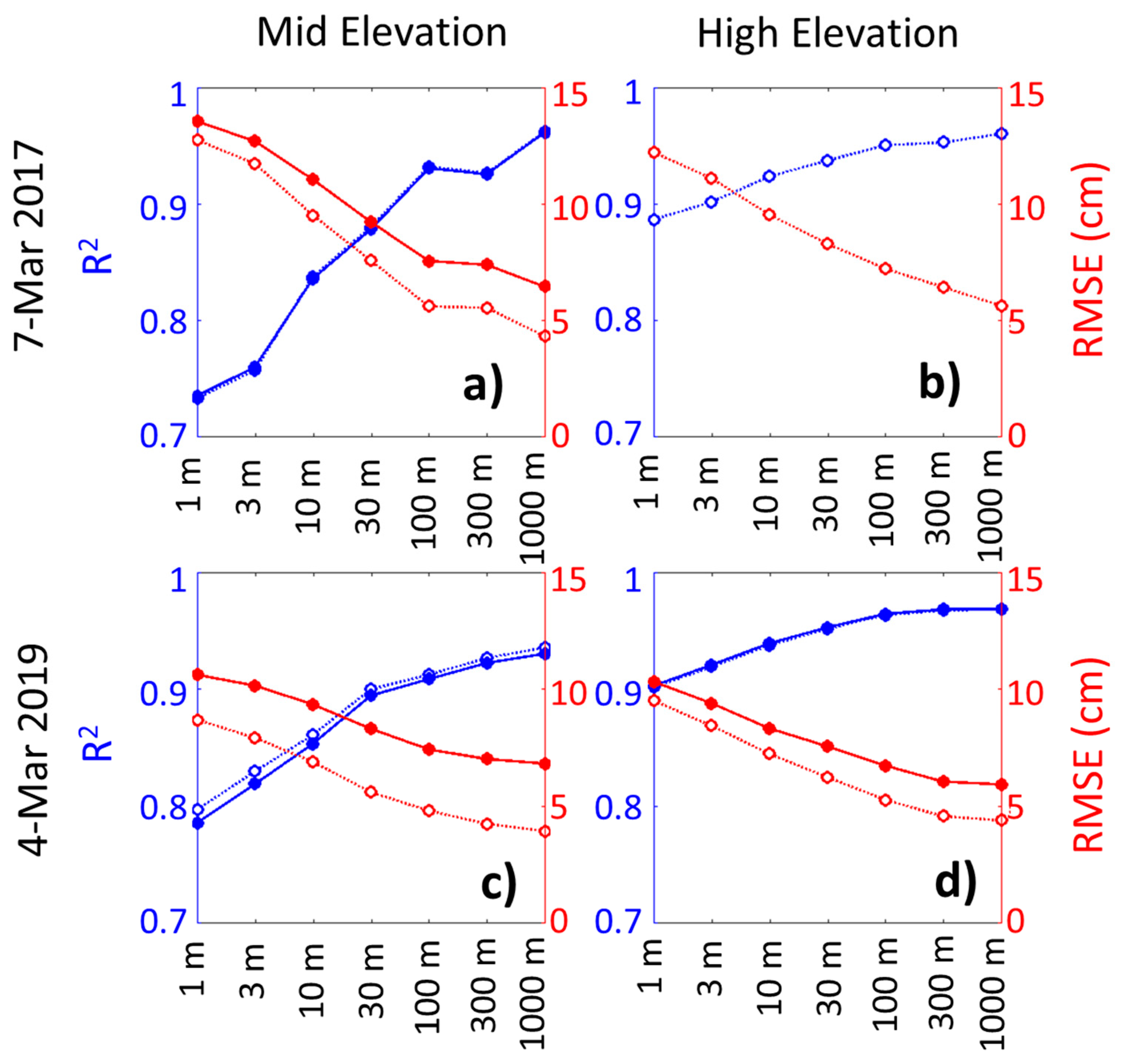
| Survey | Area 1 (ha) | Slope 2 (%) | Canopy Cover (%) | Canopy Height (m) | # Sample Locations 3 | Lidar | ||
|---|---|---|---|---|---|---|---|---|
| Mean | Median | Max | ||||||
| Montane Meadow (1 February 2017) | 5.9 | 7.4 | 12.9 | 3.4 | 0.1 | 33.4 | 94 | Y |
| Montane Meadow (5 March 2018) | 12.2 | 8.1 | 11.3 | 3.1 | 0.1 | 34.0 | 58 | N |
| Montane Meadow (4 March 2019) | 9.5 | 7.9 | 8.9 | 2.5 | 0.1 | 34.0 | 108 | Y |
| Montane Meadow (4 March 2020) | 11.6 | 8.1 | 10.3 | 2.9 | 0.1 | 34.0 | 38 | N |
| Montane Valley (5 March 2018) | 6.8 | 8.4 | 16.2 | 4.3 | 0.1 | 34.5 | 37 | N |
| Montane Valley (4 March 2019) | 6.9 | 8.2 | 12.8 | 3.8 | 0.1 | 34.7 | 37 | Y |
| Montane Valley (4 March 2020) | 7.4 | 7.9 | 13.1 | 3.9 | 0.1 | 34.7 | 22 | N |
| Dense Forest (1 February 2017) | 4.0 | 3.9 | 47.0 | 11.2 | 12.2 | 37.3 | 70 | Y |
| Dense Forest (7 March 2017) | 5.1 | 3.6 | 49.1 | 11.5 | 12.9 | 29.7 | 70 | Y |
| Dense Forest (4 March 2019) | 9.5 | 4.4 | 44.8 | 10.8 | 11.6 | 30.4 | 79 | Y |
| Thinning Comparison (4 March 2019) | 17.0 | 3.1 | 32.7 | 9.0 | 8.4 | 41.5 | 105 | Y |
| Lidar Depth (cm) | SfM Depth (cm) | Lidar CV | SfM CV | R2 | RMSE (cm) | |
|---|---|---|---|---|---|---|
| Montane Meadow (1 February 2017) | 65.1 | 62.1 | 0.26 | 0.30 | 0.78 | 9.2 |
| Montane Meadow (4 March 2019) | 75.3 | 71.8 | 0.25 | 0.26 | 0.80 | 9.4 |
| Montane Valley (4 March 2019) | 63.9 | 62.9 | 0.40 | 0.39 | 0.89 | 8.5 |
| Dense Forest (1 February 2017) | 54.3 | 48.0 | 0.29 | 0.55 | 0.23 | 24.0 |
| Dense Forest (7 March 2017) | 30.7 | 26.9 | 0.61 | 0.70 | 0.34 | 17.6 |
| Dense Forest (4 March 2019) | 34.9 | 29.6 | 0.45 | 0.55 | 0.57 | 12.4 |
| Thinning Comparison (4 March 2019) | 9.5 | 10.7 | 0.90 | 0.80 | 0.41 | 7.4 |
| SfM R2 | SfM RMSE (cm) | SfM Bias (cm) | Lidar R2 | Lidar RMSE (cm) | Lidar Bias (cm) | |
|---|---|---|---|---|---|---|
| Montane Meadow (1 February 2017) | 0.82 | 8.6 | 0.7 | 0.79 | 9.2 | 1.6 |
| Montane Meadow (4 March 2019) | 0.60 | 13.4 | −0.7 | 0.68 | 12.4 | 2.4 |
| Montane Valley (4 March 2019) | 0.90 | 9.7 | 2.7 | 0.94 | 8.5 | 4.1 |
| Dense Forest (1 February 2017) | 0.29 | 17.2 | 2.1 | 0.33 | 10.3 | 5.2 |
| Dense Forest (7 March 2017) | 0.26 | 16.3 | 1.8 | 0.40 | 9.3 | 0.8 |
| Dense Forest (4 March 2019) | 0.27 | 8.8 | −0.4 | 0.62 | 8.3 | 5.8 |
| Thinning Comparison (4 March 2019) | 0.37 | 7.9 | 2.0 | 0.46 | 7.1 | 1.9 |
| Date | Average Depth (cm) | Depth CV (-) | Average Density (g/cm3) | Density CV | Average SWE (cm) | SWE CV |
|---|---|---|---|---|---|---|
| 7 March 2017 | 52.0 | 0.63 | 0.32 | 0.05 | 17.0 | 0.65 |
| 5 March 2018 | 14.2 | 0.85 | 0.30 | 0.07 | 4.2 | 0.83 |
| 4 March 2019 | 69.3 | 0.34 | 0.33 | 0.05 | 22.7 | 0.35 |
| 4 March 2020 | 56.7 | 0.40 | 0.36 | 0.04 | 20.2 | 0.38 |
| Mean (cm) | CV | Skewness | Short-Range D 1 | Long-Range D 1 | |||||||
|---|---|---|---|---|---|---|---|---|---|---|---|
| Obs | Sim | Obs | Sim | Obs | Sim | Obs | Sim | Obs | Sim | ||
| Mid-Elevation | 7 March 2017 | 19.3 | 17.3 | 1.32 | 1.00 | 2.8 | 2.4 | 2.60 | 2.77 | 2.93 | 2.93 |
| 4 March 2019 | 21.5 | 19.0 | 0.92 | 0.64 | 1.4 | 1.8 | 2.78 | 2.73 | 2.96 | 2.96 | |
| High-Elevation | 7 March 2017 | 41.4 | 42.4 | 0.88 | 0.78 | 0.6 | 0.9 | 2.68 | 2.71 | 2.90 | 2.92 |
| 4 March 2019 | 67.5 | 64.6 | 0.45 | 0.40 | −0.3 | −0.2 | 2.78 | 2.81 | 2.91 | 2.90 | |
© 2020 by the authors. Licensee MDPI, Basel, Switzerland. This article is an open access article distributed under the terms and conditions of the Creative Commons Attribution (CC BY) license (http://creativecommons.org/licenses/by/4.0/).
Share and Cite
Broxton, P.D.; van Leeuwen, W.J.D. Structure from Motion of Multi-Angle RPAS Imagery Complements Larger-Scale Airborne Lidar Data for Cost-Effective Snow Monitoring in Mountain Forests. Remote Sens. 2020, 12, 2311. https://doi.org/10.3390/rs12142311
Broxton PD, van Leeuwen WJD. Structure from Motion of Multi-Angle RPAS Imagery Complements Larger-Scale Airborne Lidar Data for Cost-Effective Snow Monitoring in Mountain Forests. Remote Sensing. 2020; 12(14):2311. https://doi.org/10.3390/rs12142311
Chicago/Turabian StyleBroxton, Patrick D., and Willem J. D. van Leeuwen. 2020. "Structure from Motion of Multi-Angle RPAS Imagery Complements Larger-Scale Airborne Lidar Data for Cost-Effective Snow Monitoring in Mountain Forests" Remote Sensing 12, no. 14: 2311. https://doi.org/10.3390/rs12142311
APA StyleBroxton, P. D., & van Leeuwen, W. J. D. (2020). Structure from Motion of Multi-Angle RPAS Imagery Complements Larger-Scale Airborne Lidar Data for Cost-Effective Snow Monitoring in Mountain Forests. Remote Sensing, 12(14), 2311. https://doi.org/10.3390/rs12142311





